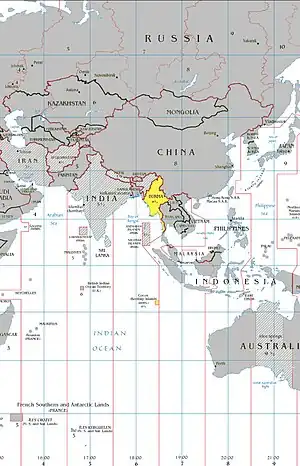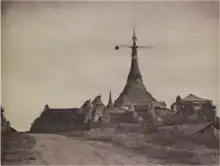| UTC+06:30 | |
|---|---|
| Time zone | |
 | |
| UTC offset | |
| UTC | UTC+6:30 |
| Current time | |
| 10:33, 15 January 2024 MMT [refresh] | |
| Central meridian | |
| Date-time group | |
Myanmar Standard Time ( Burmese: မြန်မာ စံတော်ချိန်, [mjəmà sàɰ̃dɔ̀dʑèiɰ̃]), formerly Burma Standard Time (BST), is the standard time in Myanmar, 6.5 hours ahead of UTC. Myanmar Standard Time (MMT) is calculated on the basis of 97°30′E longitude.[1] MMT is used all year round, as Myanmar does not observe daylight saving time.[2][3]
History

Pre-colonial period
Myanmar did not have a standard time before the British colonial period. Each region kept its own local mean time, according to the Burmese calendar rules: sunrise, noon, sunset and midnight.[note 1] The day was divided into eight 3-hour segments called baho (ဗဟို), or sixty 24-minute segments called nayi (နာရီ). Although the calendar consists of time units down to the millisecond level, the popular usage never extended beyond baho and at most nayi measurements; a gong was struck every nayi while a drum (စည်) and a large bell (ခေါင်းလောင်း) were struck to mark every baho.[5]
| Type | Time | Burmese name | Description |
|---|---|---|---|
| Day | 1 o'clock | နံနက် တစ်ချက်တီး | midway between sunrise and midday |
| 2 o'clock | နေ့ နှစ်ချက်တီး | noon (midday) | |
| 3 o'clock | နေ့ သုံးချက်တီး | midway between noon and sunset | |
| 4 o'clock | နေ့ လေးချက်တီး | sunset | |
| Night | 1 o'clock | ည တစ်ချက်တီး | midway between sunset and midnight |
| 2 o'clock | ည နှစ်ချက်တီး | midnight | |
| 3 o'clock | ည သုံးချက်တီး | midway between midnight and sunrise | |
| 4 o'clock | နံနက် လေးချက်တီး | sunrise |
Colonial period

The use of a common time began in British Burma in the late 19th century. The first confirmed mention of Rangoon Mean Time (RMT) at GMT+6:24:40[note 2] being in use was in 1892,[6] a year before the country's first time ball observatory[note 3] was opened in Rangoon (Yangon) on 1 October 1893.[7][8] However, the use of RMT as the common time, at least in some sectors, most probably started earlier. (The country's first rail service, between Rangoon and Prome (Pyay), began on 2 May 1877,[9] and the non-authoritative IANA time zone database says RMT was introduced in 1880.[10]) On 1 July 1905,[11][12] a new standard time called Burma Standard Time (BST) at GMT+6:30—set to the longitude 97° 30' E, and 5 minutes and 20 seconds ahead of RMT—was first adopted by the Railways and Telegraph administrations.[11][13] Although the rest of the country came to adopt BST, RMT continued to be used in the city of Rangoon at least to 1927.[note 4] By 1930, however, BST apparently had been adopted in Rangoon as well.[note 5]
The standard time was changed to Japan Standard Time (JST) during the Japanese occupation of the country (1942–1945) in World War II.[14]
After independence
The standard time was reverted to GMT+6:30 after the war.[14] It has remained ever since, even after the country's independence in 1948. The only change has been its name in English; the official English name has been changed to Myanmar Standard Time[1] presumably since 1989 when the country's name in English was changed from Burma to Myanmar.[15] The country does not observe a daylight saving time.[2]
Timeline of common times
| Name | Period | Offset from UTC | Notes |
|---|---|---|---|
| Rangoon Mean Time | 2 May 1877? – 30 June 1905 | UTC+6:24:40 | Standard time for British Burma from at least 1892 to 30 June 1905. Continued to be used in Rangoon (Yangon) at least to 1927[16] perhaps until 1929.[17] |
| Burma Standard Time | 1 July 1905 – 30 April 1942 | UTC+6:30:00 | First adopted by Railways and Telegraph offices in 1905.[11][13] The October 2021 IANA database says it was introduced in 1920[14] but does not provide a source. |
| Japan Standard Time | 1 May 1942 – 2 May 1945 | UTC+09:00:00 | Standard time during the Japanese occupation |
| Burma/Myanmar Standard Time | 3 May 1945 – present | UTC+06:30:00 |
IANA time zone database
The IANA time zone database contains one time zone named Asia/Yangon[18] for Myanmar[14]
| Country Code | Coordinates | Time Zone | Comments | UTC offset | UTC DST offset |
|---|---|---|---|---|---|
| MM | +1647+09610 | Asia/Yangon |
Asia/Rangoon |
+06:30 | +06:30 |
Notes
- ↑ (Clancy 1906: 57): The Burmese calendar recognizes two types of day: astronomical and civil. The mean Burmese astronomical day is from midnight to midnight, and represents 1/30th of a synodic month or 23 hours, 37 minutes and 28.08 seconds. The civil day comprises two halves, the first half beginning at sunrise and the second half at sunset.
- ↑ The time offset of 6:24:40 was the time used by the official time signal station in Rangoon per (Kinns 2020: 545) and the Admiralty (Admiralty 1895: 27); it was confirmed by the US Naval Intelligence report (USNI 1928: 723).
The IANA database (https://www.iana.org/time-zones, version 2021e, released on 2021-10-21) gives 6:24:47, citing a secondary source (Reed and Low, The Indian Year Book, 1936–37, pp. 27–28); to be sure, the maintainers of the database do state that "this file is by no means authoritative." The 6:24:47 figure of (Reed and Low) may have been a typographical error from the 6:24:37 time given in (Indian Railway Board 1906: 7) which states that "... in Burma 6 1/2 hours ahead of Greenwich and 5 minutes 23 [sic] seconds earlier than Rangoon time." The Railway Board's 6:24:37 is likely false as the Admiralty records from 1898 to 1922 all say the official Rangoon time (per Kinns 2020: 545) was 6:24:40. - ↑ (Kinns 2020: 544): The British apparently were using a local pagoda (later came to be known as the Signal Pagoda) in Rangoon for signaling at least since 1855, three years after their annexation of Lower Burma; but "no supporting evidence of a Rangoon time signal has been found in notices prior to 1893."
- ↑ An April 1927 dispatch by the US Naval Intelligence (USNI 1928: 723) says that the whole country, except Rangoon, used the standard time, GMT+6:30, while the city of Rangoon still used Rangoon Mean Time, which was 5 minutes 20 seconds behind Burma Standard Time (or GMT+6:24:40).
- ↑ (Kinns 2020: 545): the UK Admiralty records show that the time ball at the Rangoon time signal station was dropped twice each day, once at GMT+17:30:00 for 00:00:00 BST (i.e. GMT+6:30:00) and also at GMT+17:35:20 for 00:00:00 RMT (i.e. GMT+6:24:40); it was only in 1930 that the time ball at Rangoon was dropped for the standard time (GMT+6:30:00).
References
- 1 2 MFF 2002: 1
- 1 2 USNAO 2013: 262
- ↑ Myanmar
- ↑ Kinns 2020: 544
- ↑ Clancy 1906: 57
- ↑ Kinns 2020: 544–545
- ↑ Hydrographic 1895: 27
- ↑ Kinns 2021: 445
- ↑ Chailley-Bert 1894: 336
- ↑ IANA TZ October 2021: Burma/Myanmar
- 1 2 3 RE 1906: 346
- ↑ USBS 1935: 3
- 1 2 USNO 1906: Volume IV, Appendix II, v
- 1 2 3 4 IANA October 2021: Burma/Myanmar
- ↑ BBC News 2 December 2011
- ↑ USNI 1928: 723
- ↑ Kinns 2020: 545
- ↑ Yangon
Bibliography
- BBC News (2 December 2011). "Who, What, Why: Should it be Burma or Myanmar?". BBC News.
- Chailley-Bert, Joseph (1894). The Colonisation of Indo-China. Translated by Arthur Baring Brabant. London: A. Constable & Company.
- Clancy, J.C. (January 1906). T. Lewis; H.P. Hollis (eds.). "The Burmese Calendar: A Monthly Review of Astronomy". The Observatory. XXIX (366).
- Hydrographic Office, Admiralty (1895). "Bay of Bengal Pilot". London.
{{cite journal}}: Cite journal requires|journal=(help) - IANA Time Zone Database (2021-10-21). "Time Zone Database, 2021e". Retrieved 2022-01-01.
- Kinns, Roger (2020). "Time Signals for Mariners in India, Burma and Ceylon" (PDF). Journal of Astronomical History and Heritage. Chiang Mai: National Astronomical Research Institute of Thailand. 23 (3): 523–552. Bibcode:2020JAHH...23..523K. doi:10.3724/SP.J.1440-2807.2020.03.05. S2CID 256563687.
- Kinns, Roger (2021). "Time Signals for Mariners in Southeast Asia: Time Balls, Discs, Bells, Guns and Lights". In Wayne Orchiston; Mayank N. Vahia (eds.). Exploring the History of Southeast Asian Astronomy: A Review of Current Projects and Future Prospects and Possibilities. Cham, Switzerland: Springer. ISBN 978-3-030-62776-8.
- The Railway Board of India (1906). Administration Report on the Railways in India for the Calendar Year 1905. Simla: Manager of Publications.
- Union of Myanmar Ministry of Information (2002). Myanmar: Facts and Figures. Ministry of Information, Union of Myanmar.
- United States National Bureau of Standards (1935). Standard Time Throughout the World. Washington: United States Department of Commerce.
- United States Nautical Almanac Office (17 May 2013). The Nautical Almanac for the Year 2014. Government Printing Office. p. 262. ISBN 978-0-16-091756-1.
- United States Naval Observatory (1906). Publications of the United States Naval Observatory. Vol. IV. Washington, DC: U.S. Government Printing Office.
- United States Office of Naval Intelligence (1928). Port Directory of the Principal Foreign Ports. Washington: US Naval Department.